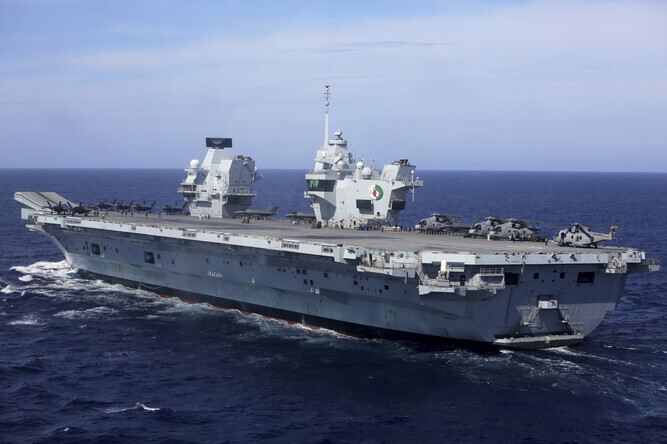hankyoreh
Links to other country sites 다른 나라 사이트 링크
UK to permanently deploy two warships in Indo-Pacific in apparent attempt to contain China

The United Kingdom announced plans to permanently deploy two of its warships in the Indo-Pacific region as of later this year.
The plans, which signal the UK’s intent to participate militarily in US efforts to contain and hem in China, are raising concerns about their position to raise tensions and the risk of military confrontation in the region.
The plans were announced by UK Secretary of State for Defence Ben Wallace at a joint press conference in Tokyo on Tuesday following his meeting with Japanese Minister of Defense Nobuo Kishi.
In a UK Defence Ministry press release, Wallace said, “Following on from the [UK carrier] strike group’s inaugural deployment, the UK will permanently assign two Offshore Patrol Vessels to the [Indo-Pacific] region from later this year [to perform coastal patrol duties in anticipation of an enemy attack].”
The HMS Queen Elizabeth-led strike group is scheduled to pass the South China Sea — a region where China is currently embroiled in territorial disputes with several Southeast Asian countries — and stop by India, Singapore and South Korea before arriving in Japan around September.
The carrier strike group consists of the Queen Elizabeth, an aircraft carrier equipped with F-35B stealth aircraft, along with destroyers, frigates and support ships.
While in Japan, the Queen Elizabeth is scheduled to put in at Yokosuka in Kanagawa Prefecture — the base of the US Seventh Fleet — while the destroyers and other warships are to variously put in at Sasebo in Nagasaki Prefecture, Okinawa and other locations.
The UK ambassador in Tokyo said there were no plans to keep a permanent base for the two offshore patrol vessels that are to be deployed to the Indo-Pacific region following the carrier strike group’s Japan visit. Japan’s Jiji Press reported that the UK is assuming Japan, Australia, and others will provide supply support for the vessels’ operation.
Wallace also said Monday that the UK would be “contributing a Littoral Response Group (LRG) in the coming years,” adding that the plans would “contribute to collective defence and security [in the Indo-Pacific region] for decades to come.” The LRG is a military organization that the UK has recently been pursuing with the aim of rapidly deploying coastal landing forces throughout the world.
In March, the UK declared its plans for increased involvement in the Indo-Pacific region with its announcement of an “integrated review” of defense, security, development and foreign policy to be applied through 2030. Wallace’s latest remarks appear to reflect that policy concept.
With the UK’s plans signaling a concrete military example of European and other Western powers rallying behind the US to counter China’s rise, many are watching to see how Beijing responds. In South Korea, some are voicing concerns that this could unfold in a way that pressures Seoul to “choose” between the US and China.
According to Reuters, the US said it welcomes Wallace’s remarks.
A Pentagon spokesperson congratulated the UK for its “commitment to an inter-connected network of allies and partners, who mutually cooperate and support freedom of navigation and a rules-based order in the Indo-Pacific region.”
By Park Byong-su, senior staff writer
Please direct comments or questions to [english@hani.co.kr]

Editorial・opinion
![[Guest essay] Preventing Korean Peninsula from becoming front line of new cold war [Guest essay] Preventing Korean Peninsula from becoming front line of new cold war](https://flexible.img.hani.co.kr/flexible/normal/500/300/imgdb/original/2024/0507/7217150679227807.jpg) [Guest essay] Preventing Korean Peninsula from becoming front line of new cold war
[Guest essay] Preventing Korean Peninsula from becoming front line of new cold war![[Column] The state is back — but is it in business? [Column] The state is back — but is it in business?](https://flexible.img.hani.co.kr/flexible/normal/500/300/imgdb/original/2024/0506/8217149564092725.jpg) [Column] The state is back — but is it in business?
[Column] The state is back — but is it in business?- [Column] Life on our Trisolaris
- [Editorial] Penalties for airing allegations against Korea’s first lady endanger free press
- [Editorial] Yoon must halt procurement of SM-3 interceptor missiles
- [Guest essay] Maybe Korea’s rapid population decline is an opportunity, not a crisis
- [Column] Can Yoon steer diplomacy with Russia, China back on track?
- [Column] Season 2 of special prosecutor probe may be coming to Korea soon
- [Column] Park Geun-hye déjà vu in Yoon Suk-yeol
- [Editorial] New weight of N. Korea’s nuclear threats makes dialogue all the more urgent
Most viewed articles
- 1Behind-the-times gender change regulations leave trans Koreans in the lurch
- 2Yoon’s revival of civil affairs senior secretary criticized as shield against judicial scrutiny
- 3Unexpected rate of AI development requires timely discussion of side effects
- 4Family that exposed military cover-up of loved one’s death reflect on Marine’s death
- 5Marines who survived flood that killed colleague urge president to OK special counsel probe
- 6Japan says its directives were aimed at increasing Line’s security, not pushing Naver buyout
- 7A breath of fresh air: Innovative architecture in the time of COVID-19
- 8‘Weddingflation’ breaks the bank for Korean couples-to-be
- 9South Korean ambassador attends Putin’s inauguration as US and others boycott
- 10Mother of Sewol victim travels 3,100km in 21 days to raise awareness about investigation into ferry